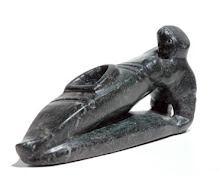
During early June of the year 1788, the Spanish frigate Princesa commanded by Esteban José Martínez and her companion, the packet-boat San Carlos under Gonzalo López de Haro, explored Prince William Sound. On 18th June, both ships, after having dispatched launches for survey work were sailing close near the southwestern end of Montague Island. On a note for his diary's entry for the day, Jose María de Narváez, a pilot who had commanded one of the launches, referred to the watercraft used by the inhabitants of the area in these terms:

"Their canoes are shaped like a harp and sheathed on the outside with little span ropes. The frames of the canoes are fabricated on the inside of very thin ribs of wood, woven into a perfectly engineered shape. In the same style, they have an enclosure in which there is a round hatch, like the mouth of an earthen jar. The Indian gets into this. No matter how much swell there is, he travels free of getting any of his body wet. His arms are free to row with small oars."

I believe that Narváez was speaking of the kayaks of the Chugach people who still live in the area.



No hay comentarios:
Publicar un comentario